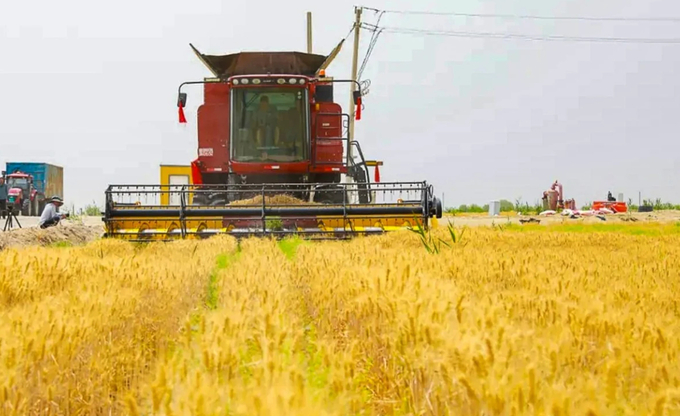May 23, 2025 | 03:35 GMT +7
May 23, 2025 | 03:35 GMT +7
Hotline: 0913.378.918
May 23, 2025 | 03:35 GMT +7
Hotline: 0913.378.918

In eastern China, growers harvest a wheat crop that uses various technologies and agricultural methods to produce wheat at the edge of the harsh Taklimakan Desert. Photo: Weibo.
The first harvest of a 400-hectare (988-acre) wheat crop is under way in the southwestern edge of the Taklimakan Desert in Xinjiang Uygur autonomous region in western China, according to state media.
China has the largest area of desertified land in the world. Its almost 300 million hectares of desertified land – land that has been degraded because of a variety of factors – affects the production and lives of more than 400 million people, according to official figures.
Wang Jianjun, deputy manager of Xinjiang Wuzheng Green Agriculture Development Company, said the project’s unit yield exceeded expectations.
“This batch of wheat weighs 825 grams per litre, meeting the standard for first-class wheat of the wheat yield measurement, and the yield exceeds 260kg per mu,” Wang told China News Service this week. A mu is a unit of measurement commonly used in China, with 15 mu equivalent to 1 hectare and about 6 mu equalling 1 acre.
He said the company aimed for a 400kg unit output by improving plantation technologies.
China has ramped up its push for food security in recent years amid volatile global markets, the effects of climate change on food sources and geopolitical complications.
The winter wheat was planted in October in Makit county on the southwestern edge of the desert in China’s inland Kashgar prefecture in Xinjiang.
Makit is typical of a desert climate, with an average annual rainfall of 42.3mm and average evaporation of 2,349mm a year, according to Xinjiang weather bureau statistics from 2021.
“After withstanding overwintering, resisting sandstorm and drought, the wheat seedlings have successfully survived,” Wang said.
To grow wheat in harsh conditions, the Wuzheng group based in Shandong province developed a method of cultivation and water and fertiliser management specifically to grow crops in the desert.
Wang and his team increased the application of organic matter and soil conditioners and adopted “fertigation” technology – which allows crops to absorb nutrients through irrigation – a method that improves the accuracy and efficiency of water and fertilisers.
The water-fertiliser operation is timed and quantified through a mobile app to save on both resources, Wang said.
The team is set to expand the desert wheat planting area to beyond 3,300 hectares within five years, deputy director of Makit county’s Agriculture and Rural Affairs Bureau, Han Yong, said.
Xinjiang, which has one-third of China’s saline-alkali land, has worked to increase agricultural production.
In 2023, its annual grain output reached a record high 21.2 million tonnes, with a yield that ranks second nationwide. This year, it aims for an annual total grain output of at least 22 million tonnes, according to China’s agriculture ministry.
The region’s grain planting area in 2023 reached 2.8 million hectares, according to Xinhua.
The region also positions itself as a supplier of the nation’s agricultural and animal husbandry products.
Wheat is not the first crop to be grown in Xinjiang’s desertified land. In 2018, Chinese scientists successfully harvested over 470 hectares of a drought-resistant upland rice in the region, a breed they had developed in the Gobi desert.
The rice breed is better suited to the arid environment of Xinjiang than the unmodified rice, according to Xinjiang Daily.
(SCMP)

(VAN) Alt Carbon has raised $12 million in a seed round as it plans to scale its carbon dioxide removal work in the South Asian nation.

(VAN) Attempts to bring down the price of the Japanese staple have had little effect amid a cost-of-living crisis.

(VAN) Fourth most important food crop in peril as Latin America and Caribbean suffer from slow-onset climate disaster.

(VAN) Shifting market dynamics and the noise around new legislation has propelled Trouw Nutrition’s research around early life nutrition in poultry. Today, it continues to be a key area of research.

(VAN) India is concerned about its food security and the livelihoods of its farmers if more US food imports are allowed.

(VAN) FAO's Director-General emphasises the need to work together to transform agrifood systems.

(VAN) Europe is facing its worst outbreak of foot-and-mouth since the start of the century.